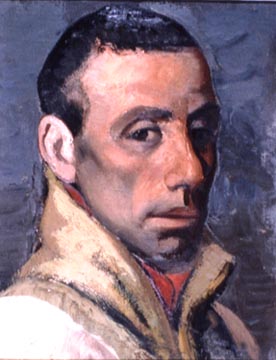
Rico Lebrun
Italian, 1900-1964 (active America)
Self Portrait, 1940
oil on canvas
16 x 12 in.
SBMA, Gift of Mr. and Mrs. Girard Van B. Hale
1950.5.1
COMMENTS
The Life of Rico Lebrun
Rico Lebrun, native to Italy, can be seen as a humanist artist. The human figure plays a seminal element in his work, which seeks to express as James Thrall Sobey said, "man's inhumanity to man". The effects of war and murder, nuclear holocaust and calculated genocide can be seen as his main themes. He also depicted clowns, harlequins, and beggars which haunted him in his childhood. He chose to express the brutality of a world in turmoil.
Rico Lebrun was born on December 10, 1900 in Naples. He graduated from the National Technical School in Naples at the age of 14. Three years later, he completed his schooling at the National Technical Institute and soon after, joined the Italian Army. During his military service he was encouraged to attend drawing classes at the Naples Academy of Fine Arts. Lebrun spent his spare time in the Museum of Naples studying and copying the Seicento Masters.
Mainly self-taught, Lebrun attained skills in draftsmanship and soon became a designer and supervisor in a major stained-glass factory in 1922. The factory opened a new branch in Springfield, Illinois where he emigrated and was employed as a foreman for one year.
Lebrun than left to New York and became a commercial artist, working for major magazines like the New Yorker and Vogue. During his stay in New York he married Portia Novello, a designer.
Lebrun made frequent visits to his native Italy, which deeply effected his life. As the years went on though, he made less visits.
He worked with Louis Rubenstein, a painter on fresco experiments at Harvard and in New York. Together they produced a mural on the walls of Harvard's Fogg Museum which was later covered up.
In 1936 he worked as a WPA muralist and at the Art Students League as a teacher. Due to a conflict with his mural work and the breakup of his marriage, Lebrun moved to California.
Santa Barbara is where he met his wife Elaine Leonard. He became active at the Walt Disney Studios where he taught animation and lectured on anatomy. He played a central role in articulating the animal in the film Bambi.
He began work as a faculty member at the Chouinard Art Institute and soon after, met Donald Bear, the Director of the Denver Art Museum, later to become the founding director of the Santa Barbara Museum of Art. Bear invited Lebrun to become the Museum's artist-in-residence between 1945-47.
In 1946, his wife commits suicide and a year later he takes on a new job as master instuctor at the Jepson Art Institute in Los Angeles. He than meets Constance Johnson and they marry in 1947.
He began to depart from the preoccupation of the human figure when he began to spend much time in the Santa Ynez Valley near Santa Barbara, He became fascinated by the plant life and even the farm machinery.
After his preoccupation with his Farm Implements series, he began to work on the dramatic crucifixion cycle.
Between 1953 and 1954 he was accepted to a teaching position at the Instituto Allende in San Miguel, Mexico. Mexico awoken his senses of Italy, unlike the metropolitan Los Angeles.
In Mexico, he discovered a new dimension of light and color, never seen before in his earlier works. After a year and a half, he returned to Los Angeles where he began a series of drawings and paintings based on the Holocaust.
Towards the last years of his life, he executed a mural Genesis, at Pomona College. He turned to sculpture in 1962, where he excuted 30 sculptures in the last two years of his life. Striken by cancer, Lebrun died May 9, 1964 in his Malibu home.
Rico Lebrun believed that the human being held power and strength. Lebrun sought to express this by delving into the human soul.
No original name or date given.
- Transcribed for SBMA Docent website 2008, Loree Gold.
SBMA CURATORIAL LABELS
The resemblance of this confident self-portrait to Blue Period self-portraits by Picasso is not accidental. By the time he recorded his features in this canvas, Lebrun was a leading modernist in the Los Angeles area, known for the sophistication and ambition of his art. Years spent in Italy studying Renaissance mural paintings, combined with artistic alliances not only with Picasso, but a whole host of European leaders of the avant-garde, meant that Lebrun was uniquely positioned to advocate for public art of the highest modernist ideals. Impelled by the human tragedy of the Holocaust, Lebrun took on commissioned murals that treated universal themes of suffering, often mobilizing timeworn Christian subjects articulated through
Picasso-esque distortions of the human figure. Twice recognized with the distinction of a Guggenheim fellowship, Lebrun was also designated artist-in-residence by SBMA director, Donald Bear. At the end of his career, which was cut short by cancer, Lebrun held a faculty position at the University of California, Santa Barbara.
- Highlights of American Art, 2020
